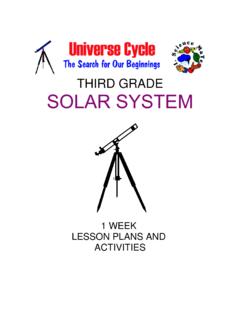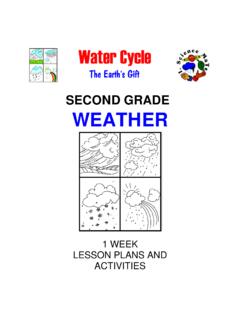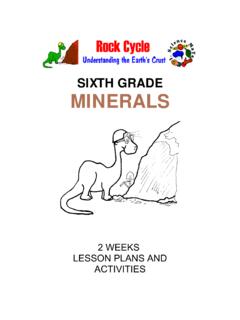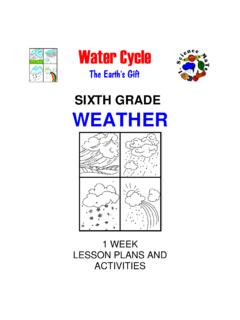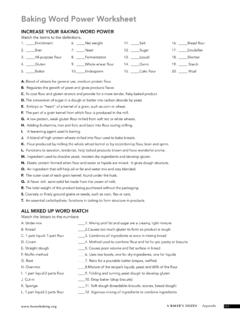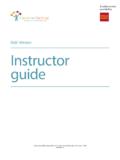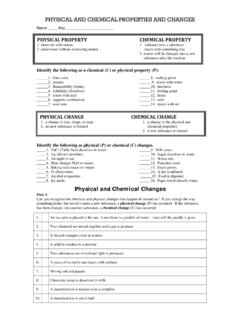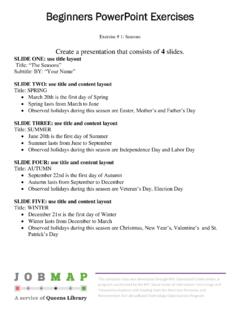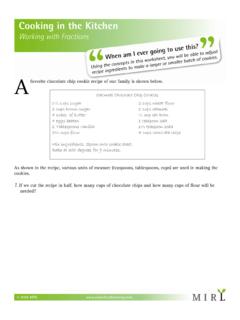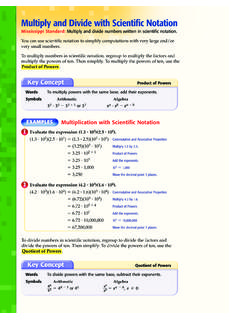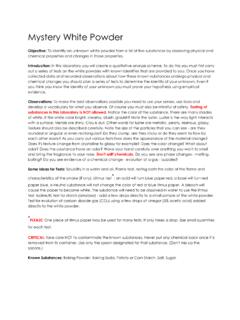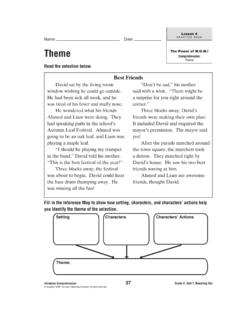Transcription of SECOND GRADE VOLCANOES - msnucleus.org
1 SECOND GRADEVOLCANOES1 WEEKLESSON PLANS ANDACTIVITIESMath/Science Nucleus 1990, 20012 PLATE TECTONIC CYCLEOVERVIEW OF SECOND GRADEVOLCANOESWEEK : Investigating the parts of a : Comparing the parts of a volcano to different types of : Discovering that VOLCANOES occur around the : Discovering earthquake : Tracing a fault map of the San Francisco Bay : Exploring how deep you can drill into the TECTONICSWEEK : Exploring how the Earth's outermost portion : Exploring the results of movement on the Earth's : Exploring how plates have moved through : Discovering how to think during an : Assessing what a mayor should do during a strong, moderate, and weak : Analyzing earthquake safety at Nucleus 1990, 20013 Students draw and compareparts of , Italy, remnants of ancient volcanic eruptions.
2 PLATE TECTONIC CYCLE - VOLCANOES (2)PRE LABOBJECTIVES:1. Investigating the parts of a Distinguishing between magma and :craterlavamagmaventMATERIAL: papercrayonsBACKGROUND:Volcanic eruptions provide clues for understanding what is happening to the outerpart of the Earth. VOLCANOES are evidence that the Earth is restless, especially within thecrust and upper mantle. The source of the molten rock, which geologists call magma, isactually not the center of the Earth, but primarily the top 100 km (crust and upper mantle)of the planet. Since we cannot drill holes this deep, volcanic rocks provide importantinformation about rocks and processes on the outer portion of the VOLCANOES help geologist define the edges of plate boundaries.
3 The platesare the outer, rigid, solid rock skin of the Earth. They are composed of the Earth s crustand upper mantle. The plates move through time. Plates have moved together, away, andslide past each other. These motions generate VOLCANOES and earthquakes. Volcanoesare most common where plates come together (converging) and pull apart (diverging). The parts of a volcano include a reservoir of magma inside the Earth, called amagma chamber. The magma chamber is connected to the surface of the Earth by oneor more vents. The magma moves upward through the vent because the magma is lessdense than the surrounding rock.
4 It breaks through the surface of the Earth at thevolcano s crater. If the lava is liquid enough it will cause a lava flow. There are many different types of VOLCANOES , reflecting the different compositionsof magma and types of eruptions. Different vulcanologists (people who study VOLCANOES )sometimes classify them differently. In our scheme we use the simplified GeologicalSurvey classification. Math/Science Nucleus 1990, 20014A volcano that is composed completely of lava is called a shield volcano. Kilaueain Hawaii is an example. A composite volcano, like Mt.
5 St. Helens in Washington iscomposed of lava and other volcanic rocks like scoria, ash, and volcanic breccia that areformed by explosive eruptions. A cinder volcano is composed of just scoria (cinder is anold term for scoria) and :1. Inform students that this lesson will start a unit on Plate Tectonics, or the studyof earthquakes, VOLCANOES , and moving plates. Ask the students if they remember whata plate is. If they do not know, tell them that over the next few weeks they will learn!Explain that a plate is a part of the crust and upper mantle that "floats" on a layer of moreliquid rock (asthenosphere).
6 Remind students that the plates move, and that plate motioncauses VOLCANOES , earthquakes, and mountain ranges. This happens most often at theedges of plates, at plate Draw the picture on the right. Explainthe different parts of a volcano to the the students copy the words ontothe picture on their worksheet . Have themcolor their pictures. Ask them to use theirimaginations. Hang their completed picturesaround the classroom. 3. The main concept for the students tolearn is that hot molten rock is called magmawhen it is inside the Earth, and that when thehot molten rock reaches the surface of the Earth it is called lava.
7 They should also learnthe other parts of a volcano described above. 4. Ask the children if there are any major chemical differences between magma andlava from the same volcano. The answer is "no." Geologists give magma and lavaseparate names to signify whether the molten rock is located inside or outside of the difference between magma and lava is apparent when the molten rock cools. Whenmagma cools inside the Earth, it has large minerals, because it cools slowly. Lava hasvery small minerals because it cools To help the students understand the difference in appearance between lava andmagma, use an analog that they can relate to.
8 For example, an unfrosted chocolate cakelooks different on the inside than on the outside. The inside of the cake is airy and full ofholes, this can be related to magma. The outside of the cake is solid and dry, this can berelated to lava. However, even though the inside and outside appear different, they bothcome from the same recipe, as did both the magma and Nucleus 1990, 20015 PLATE TECTONIC CYCLE - VOLCANOES (2) PRE LABLABEL THE PARTS OF A VOLCANO AS YOUR TEACHER WRITES THEM ON THEBOARD. COLOR THE Nucleus 1990, 20016 Students create analogs forlava and TECTONIC CYCLE - VOLCANOES (2)LABOBJECTIVES:1.
9 Exploring the products of a Comparing the parts of a volcano to different types of :ashcraterlavamagmaventvolcanic mudMATERIALS: lab sheettoothpastevinegarbaking sodaflask (or graduated cylinder)panmodel volcano pictures of recent VOLCANOES (Internet)BACKGROUND: VOLCANOES are a subject that fascinate young and not so young students alike. Thepower and the mystery of a volcanic event is truly an earthy phenomena. Studentssometimes have a difficult time understanding that the shape of a volcano grows or buildsup through time and it builds from the inside out.
10 Eruption after eruption builds a mountainlike structure,The various styles of eruptions and magma compositions build different types ofvolcanoes. Young children have a difficult time understanding how an eruption this lab, students are asked to look at analogs for a couple of eruptive styles that maybe more familiar to them. In later grades, students will be exposed to other eruptive stylesModels can help students understand a subject if used correctly. However, mostmodels are not to scale nor totally correct. In this exercise students will look at different"models" of a volcano and try to decide which parts are analogous to a real volcano.
